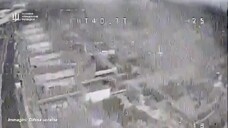International researchers led by Italy have identified the seismic signature of Mediterranean Hurricanes, or Medicanes, the small-scale tropical cyclones typical of the Mediterranean that can cause waves up to 3.5m in height.
Between 2011 and 2023 there were nine such hurricanes according to the study coordinated by Andrea Cannata of the University of Catania and the Etnean Observatory of the National Institute of Geophysics and Volcanology, and which also involved researchers from the universities of Palermo, Bari and Malta and from Ispra, and which is published in the journal Science of the Total Environment.By analysing the small vibrations or microseisms on the ground produced by waves on the coast, researchers have now managed to identify the seismic signature typical of Medicanes, distinguishing it from that of normal storms.
"The study has shown how microseisms contain valuable information for monitoring the temporal and spatial development of extreme weather and sea phenomena," said Cannata.
The discovery will make it possible to use the vast network of seismic surveys along the Mediterranean coasts to monitor and predict the evolution of these fearsome storms that are becoming increasingly frequent due to global warming.
Riproduzione riservata © Copyright ANSA













